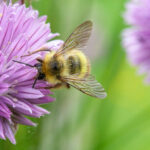Bee-gone extinction: How the decline of bees threatens humanity’s harvest
 (NaturalHealth365) Did you know? According to the American Museum of Natural History, it’s been estimated that anywhere from 100 to 10,000 species – ranging from microscopic organisms to big plants and animals – go extinct each year. One animal species that is at risk today? Bees.
(NaturalHealth365) Did you know? According to the American Museum of Natural History, it’s been estimated that anywhere from 100 to 10,000 species – ranging from microscopic organisms to big plants and animals – go extinct each year. One animal species that is at risk today? Bees.
Honey bees, in particular – both wild and domestic – are responsible for the vast majority of the world’s pollination, which is essential for food production and growth. But a new study published in Environmental Health Perspectives reveals a shocking reality: the massive decline in bees and other pollinators is already responsible for half a million early human deaths per year, namely by interrupting the global food supply. The truth is simple – if we lose bees, we all lose.
Proliferation of new pesticides, other factors to blame for the scary decline in global bee population – and we’re all affected by it
The widespread use of pesticides – many of which are resistant to degradation and can persist in the environment for years and decades – isn’t the only thing threatening our world’s bee population. Air pollution, drought, and land and habitat destruction certainly aren’t helping.
But we have to ask: when Big Ag corporations realize massive profits thanks to their powerful, widespread, and often unregulated pesticide products (which they claim are essential for improving the world’s food supply), who is really suffering the consequences? The answer is simple: all of us.
According to Greenpeace USA, one single bee colony can pollinate as many as 300 million flowers per day. But it’s not just the flowers we have to worry about. 70 out of the 100 most common cultivated crops – which include things like apples, blueberries, tomatoes, bananas, avocados, cashews, and almonds and contribute to about 90 percent of the world’s food supply – are pollinated by bees. Here’s why that’s relevant:
The world’s bee population is declining at an alarming rate.
According to the U.S. National Agricultural Statistics, the United States alone experienced a 60 percent reduction in the number of honey bee hives between 1947 and 2008. And without bees, experts warn, the global ecosystem would be seriously threatened, and humans would face the loss of diverse, nutrient-dense, and affordable produce – which could cost us our health, autonomy, and freedom from profit-driven corporate entities looking for even more ways to own the world’s food chain.
And to be clear: however strongly agricultural companies like Bayer, DuPont, and Monsanto try to deny it, the widespread use of chemicals, including neurotoxic insecticides called neonics, is having a huge and dangerous impact on pollinators. Studies have already shown that more than 150 chemical residues are regularly identified in bee pollen alone!
And yet … we continue to see captured agencies like the U.S. Environmental Protection Agency (EPA) continue to approve harmful pesticides that are known to kill bees, butterflies, and birds.
So, what can be done? Check out these small things you can do to help save the bees
We call on major corporations, economic systems, policymakers, and global leaders to take meaningful, transparent, cost-effective, and science-based action toward preserving the environment and protecting our future generations. In the meantime, there are also things we can do on an individual level to help support the population of honey bees and other pollinators, including birds and butterflies.
The Bee Conservancy is a nonprofit organization “dedicated to protecting bees, safeguarding the environment, and securing food justice through community-based education, research, habitat creation, and advocacy.” On its website, the organization lists a variety of ways you can help save bees and make a positive impact on the environment. Here are a few ideas to get you inspired:
- Support your local beekeepers by purchasing their products and donating to local beekeeping groups
- Plant trees or start a “bee garden” with flowers that have a variety of shapes, sizes, colors, and bloom times – but skip the chemical pesticides and herbicides!
- When doing yard work, wait until the springtime to cut back dead flower stocks and leave old stems up to 24 inches high, as this provides homes for cavity-nesting bees – about one-third of all bees live in hollow plant stems, logs, or holes inside trees!
That’s not all you can do, of course. Upgrade your household cleaning products to organic and non-toxic options. Vote for political leaders whom you believe will champion environmental causes and hold agencies and corporations accountable for their actions.
And whenever your budget allows, support local, organic, and regenerative farmers when searching for produce and animal products. Why? Because the decimation of grasslands and forests for the establishment of mono-crop farmlands destroys wild bee habitats and exposes even more of the environment to pesticides.
So, vote with your money and support environmentally-conscious food suppliers and operations – it can go a long way toward helping out our planet overall.
Sources for this article include:
AMNH.org
NIH.gov
Britannica.com
Commondreams.org
Thebeeconservancy.org
ABCnews.go.com
Childrenshealthdefense.org



